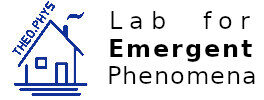Master thesis – Benedikt Decker
Benedikt Decker
Phase field crystal models of quasicrystals
[PDF]
finished 2017-12
supervised by Michael Schmiedeberg
Abstract
Understanding the formation of micro-structures often involves computer simulations. With present-day computers, common methods like molecular dynamics (MD) are limited in timespan, lengthscale and number of particles they can handle. Phase field crystal (PFC) models employing a Swift-Hohenberg-like free energy constitute a computationally efficient alternative for studying crystal structures and their dynamics. They use a coarse-grained free energy expansion with respect to a scalar field that can be associated with a particle density and are widely used to explore the formation of periodic patterns. It is known that by modifying the phase field crystal model to include a second preferred length scale, quasicrystalline structures can be obtained. Quasicrystals are structures with long-range order that are not periodic in physical space. Most computational discoveries of quasicrystals so far are restricted to 2-dimensional physical space. In this thesis the phase field crystal model for quasicrystals is extended to 3-dimensional space. A rough overview of the phase diagram of the extended phase field crystal model in three dimensions is given. Among the versatile zoo of different stable and metastable phases in three dimensions, two 2-dimensional stacked quasicrystalline phases have been found. Furthermore it is demonstrated that various different methods which are successfully applied in 2-dimensional simulations are not sufficient to grow stable structures with icosahedral symmetry.
Understanding the formation of micro-structures often involves computer simulations. With present-day computers, common methods like molecular dynamics (MD) are limited in timespan, lengthscale and number of particles they can handle. Phase field crystal (PFC) models employing a Swift-Hohenberg-like free energy constitute a computationally efficient alternative for studying crystal structures and their dynamics. They use a coarse-grained free energy expansion with respect to a scalar field that can be associated with a particle density and are widely used to explore the formation of periodic patterns. It is known that by modifying the phase field crystal model to include a second preferred length scale, quasicrystalline structures can be obtained. Quasicrystals are structures with long-range order that are not periodic in physical space. Most computational discoveries of quasicrystals so far are restricted to 2-dimensional physical space. In this thesis the phase field crystal model for quasicrystals is extended to 3-dimensional space. A rough overview of the phase diagram of the extended phase field crystal model in three dimensions is given. Among the versatile zoo of different stable and metastable phases in three dimensions, two 2-dimensional stacked quasicrystalline phases have been found. Furthermore it is demonstrated that various different methods which are successfully applied in 2-dimensional simulations are not sufficient to grow stable structures with icosahedral symmetry.
